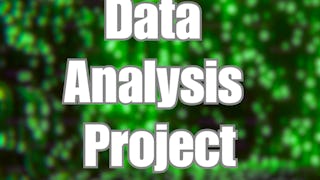This course is the sixth of eight courses. This project provides an in-depth exploration of key Data Science concepts focusing on algorithm design. It enhances essential mathematics, statistics, and programming skills required for common data analysis tasks. You will engage in a variety of mathematical and programming exercises while completing a data clustering project using the K-means algorithm on a provided dataset.





Statistics and Clustering in Python
This course is part of Data Science Foundations Specialization

Instructor: Robert Zimmer
2,334 already enrolled
Included with
(21 reviews)
What you'll learn
In this course you will engage in a variety of mathematical and programming exercises while completing a data clustering project.
Skills you'll gain
Details to know

Add to your LinkedIn profile
See how employees at top companies are mastering in-demand skills

Build your subject-matter expertise
- Learn new concepts from industry experts
- Gain a foundational understanding of a subject or tool
- Develop job-relevant skills with hands-on projects
- Earn a shareable career certificate

There are 4 modules in this course
This week, we will delve into the core concepts of mean, variance, and other basic statistics, laying the groundwork for a solid understanding of data analysis principles. Through hands-on exercises and demonstrations in Python and Jupyter notebooks, we'll explore practical techniques for calculating and interpreting statistical measures.
What's included
10 videos7 readings10 assignments1 peer review1 ungraded lab
This week, we will explore mathematics for multidimensional data. You will also learn how to work with multidimensional data in Python.
What's included
14 videos10 readings14 assignments
This week, we will explore data manipulation and visualisation with Python's Pandas library. We will dive deep into the versatile capabilities of Pandas, empowering you to efficiently manipulate, analyse, and interpret data.
What's included
6 videos6 readings7 assignments1 peer review
This week, we will embark on a journey through the fascinating world of unsupervised learning, where patterns emerge from data without explicit guidance. You will implement the K-means algorithm to solve a real-world problem.
What's included
8 videos3 readings3 assignments3 peer reviews5 discussion prompts
Earn a career certificate
Add this credential to your LinkedIn profile, resume, or CV. Share it on social media and in your performance review.
Instructor

Explore more from Data Analysis
 Status: Preview
Status: PreviewUniversity of London
 Status: Free Trial
Status: Free TrialUniversity of Colorado Boulder
 Status: Preview
Status: Preview
Why people choose Coursera for their career





Open new doors with Coursera Plus
Unlimited access to 10,000+ world-class courses, hands-on projects, and job-ready certificate programs - all included in your subscription
Advance your career with an online degree
Earn a degree from world-class universities - 100% online
Join over 3,400 global companies that choose Coursera for Business
Upskill your employees to excel in the digital economy
Frequently asked questions
To access the course materials, assignments and to earn a Certificate, you will need to purchase the Certificate experience when you enroll in a course. You can try a Free Trial instead, or apply for Financial Aid. The course may offer 'Full Course, No Certificate' instead. This option lets you see all course materials, submit required assessments, and get a final grade. This also means that you will not be able to purchase a Certificate experience.
When you enroll in the course, you get access to all of the courses in the Specialization, and you earn a certificate when you complete the work. Your electronic Certificate will be added to your Accomplishments page - from there, you can print your Certificate or add it to your LinkedIn profile.
Yes. In select learning programs, you can apply for financial aid or a scholarship if you can’t afford the enrollment fee. If fin aid or scholarship is available for your learning program selection, you’ll find a link to apply on the description page.
More questions
Financial aid available,
¹ Some assignments in this course are AI-graded. For these assignments, your data will be used in accordance with Coursera's Privacy Notice.




